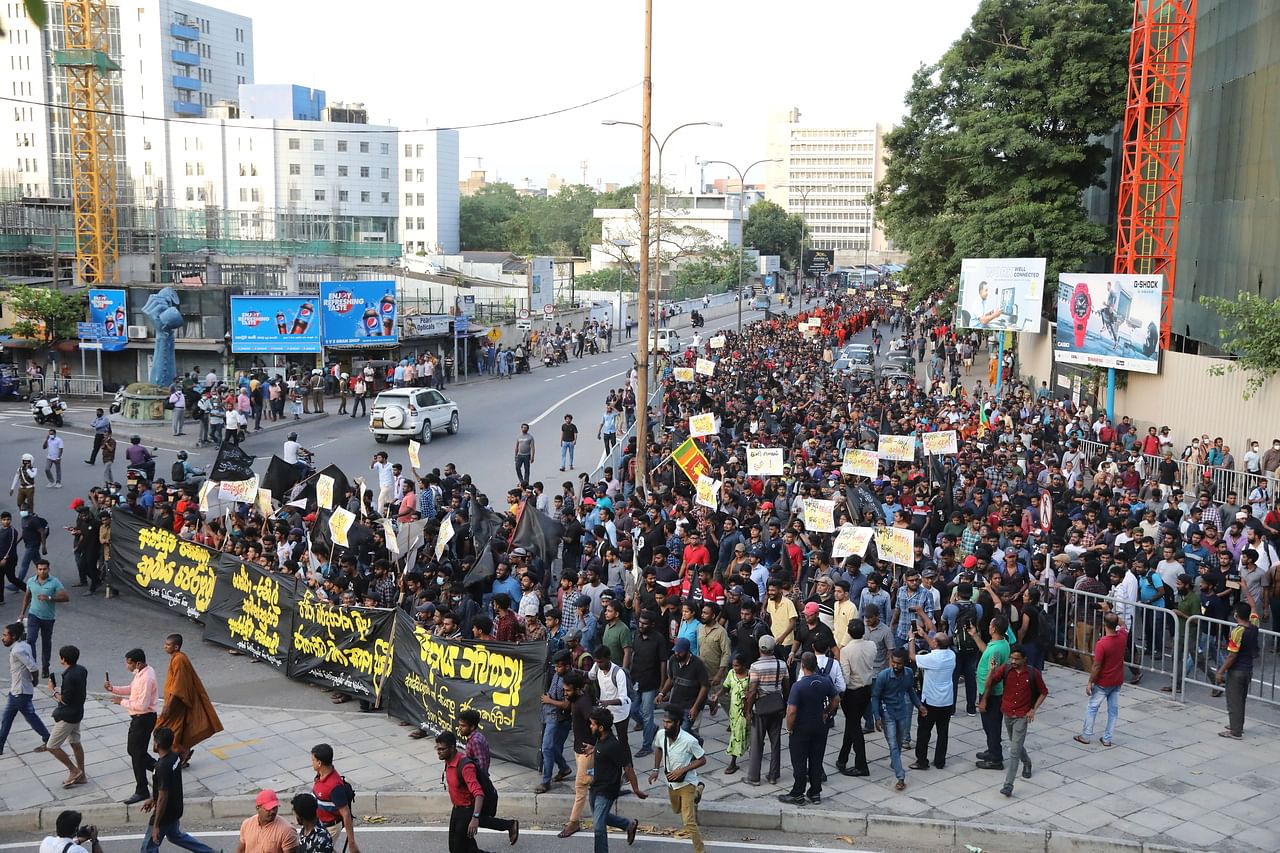Sri Lanka protesters, angered by economic meltdown, storm President’s house
Sign up now: Get insights on Asia's fast-moving developments
Follow topic:
COLOMBO (REUTERS, AFP, BLOOMBERG) - Thousands of protesters in Sri Lanka’s commercial capital Colombo broke through police barricades and stormed the President’s official residence and his secretariat on Saturday (July 9) amid months of mounting public anger over the country's worst economic crisis in seven decades.
Some protesters, holding Sri Lankan flags and helmets, broke into the President’s residence, video footage from local TV news NewsFirst channel showed.
Thousands of protesters also broke open the gates of the sea-front presidential secretariat, which has been the site of a sit-in protest for months, and entered the premises, TV footage showed.
Military personnel and police at both locations were unable to hold back the crowd, as they chanted slogans asking President Gotabaya Rajapaksa to step down.
Two defence ministry sources said President Rajapaksa was removed from the official residence on Friday for his safety ahead of the planned rally over the weekend.
Prime Minister Ranil Wickremesinghe on Saturday summoned an emergency party leaders meeting to discuss the situation and come to a swift resolution, his office said in a statement. He has also requested the speaker to summon Parliament, the statement said.
Mr Wickremesinghe has also been moved to a secure location, a government source said.
A Facebook live-stream from inside the president’s house showed hundreds of protesters, some draped in flags, packing into rooms and corridors, shouting slogan’s against Mr Rajapaksa.
Video clips shared widely on social and local media showed protesters taking a dip in the official pool, taking selfies on the President's bed, helping themselves to food in the presidential kitchen, and playing the piano in the lounge.
Hundreds also milled about on the grounds outside the colonial-era, white-washed building. No security officials were visible.
At least 21 people, including two police were injured and hospitalised in the ongoing protests, hospital sources said.
Economic collapse
The island of 22 million people is struggling under a severe foreign exchange shortage that has limited essential imports of fuel, food and medicine, plunging it into the worst financial turmoil since independence in 1948.
The crisis comes after Covid-19 hammered the tourism-reliant economy and slashed remittances from overseas workers, and has been compounded by the build-up of huge government debt, rising oil prices and a ban on the import of chemical fertilisers last year that devastated agriculture.Many blame the country’s decline on President Rajapaksa. Largely peaceful protests since March have demanded his resignation.
Thousands of people swarmed into Colombo’s government district, shouting slogans against the President and dismantling several police barricades to reach Mr Rajapaksa’s house, a witness said.
Thousands of people swarmed into Colombo’s government district, shouting slogans against the President and dismantling several police barricades to reach Mr Rajapaksa’s house, a witness said.
Police fired shots in the air but were unable to stop the angry crowd from surrounding the presidential residence, the witness said.
Reuters could not immediately confirm the President’s whereabouts.
Despite a severe shortage of fuel that has stalled transportation services, demonstrators packed into buses, trains and trucks from several parts of the country to reach Colombo to protest against the government’s failure to protect them from economic ruin. Discontent has worsened in recent weeks as the cash-strapped country stopped receiving fuel shipments, forcing school closures and rationing of petrol and diesel for essential services.
Mr Sampath Perera, a 37-year-old fisherman, took an overcrowded bus from the seaside town of Negombo 45km north of Colombo, to join the protest.
"We have told Gota over and over again to go home but he is still clinging on to power. We will not stop until he listens to us,” Mr Perera said.
He is among the millions squeezed by chronic fuel shortages and inflation that hit a record 54.6 per cent in June.
Political instability could undermine Sri Lanka’s talks with the International Monetary Fund seeking a US$3 billion (S$4.19 billion) bailout, a restructuring of some foreign debt and fund raising from multilateral and bilateral sources to ease the dollar drought.
Mr Gotabaya has side-stepped demands for his resignation and appointed long-time opponent Ranil Wickremesinghe as Prime Minister in May after the largely peaceful protests turned violent.
Late on Friday, police imposed a curfew in and around parts of Colombo after thousands of university students, who had marched towards Mr Rajapaksa’s residence, were tear-gassed.
Police chief C.D. Wickramaratne – who told a briefing this week that authorities would not stop any peaceful rallies – said in a statement on Saturday that the curfew would be lifted by 8am local time.
Thousands of anti-government protesters ignored the curfew and even forced railway authorities to operate trains to take them to Colombo for Saturday’s rally, officials said.
“The curfew was not a deterrent, in fact it encouraged more people to get on the streets in defiance,” a top defence official told AFP.
“Passengers had commandeered trains to reach Colombo.”
Thousands of anti-government protesters ignored the curfew and even forced railway authorities to operate trains to take them to Colombo for Saturday’s rally, officials said.
“The curfew was not a deterrent, in fact it encouraged more people to get on the streets in defiance,” a top defence official told AFP.
“Passengers had commandeered trains to reach Colombo.”

Nine people were killed and hundreds wounded when clashes erupted across the country after Rajapaksa loyalists attacked peaceful protesters outside the President’s office in May.
Economic activity in the country has come to a grinding halt, with residents urged to stay home until July 10 to save fuel.

